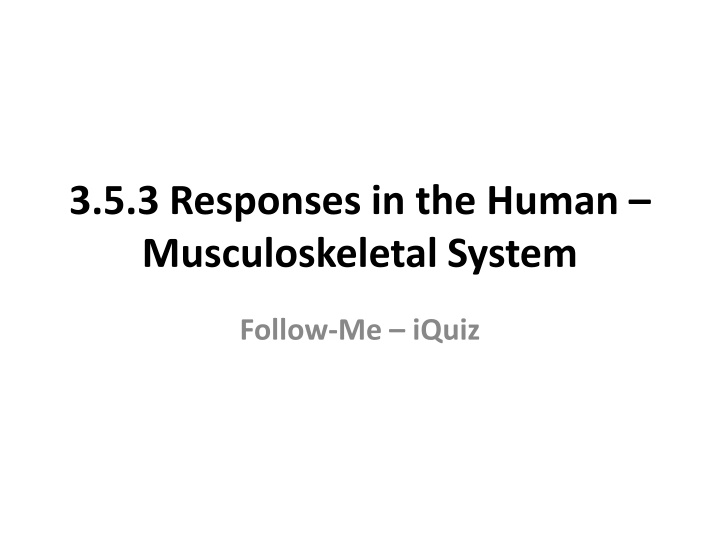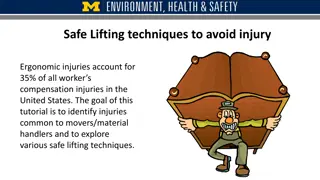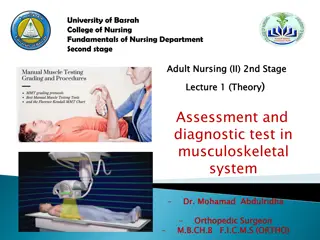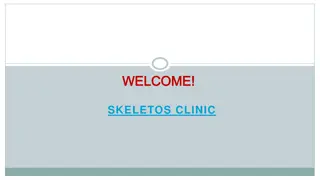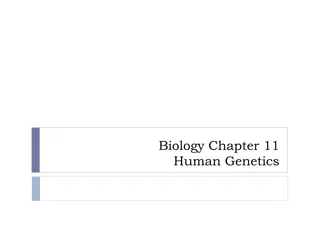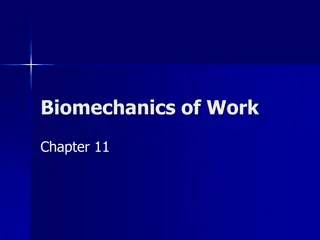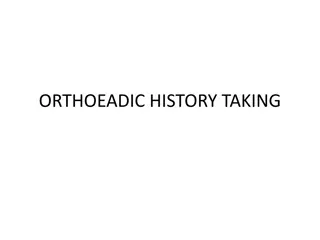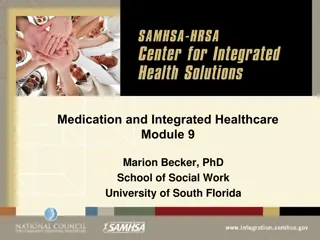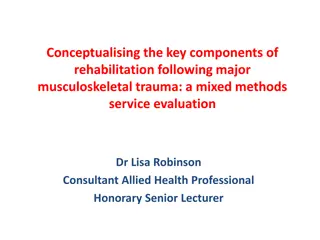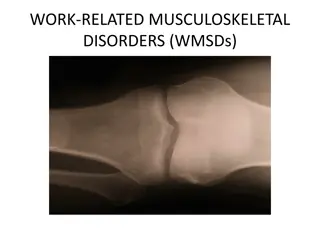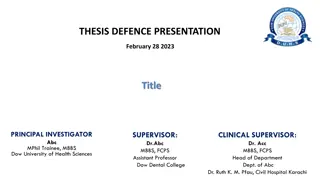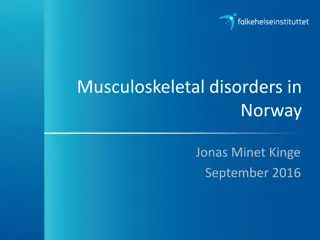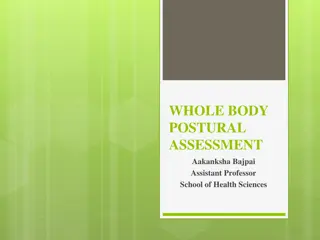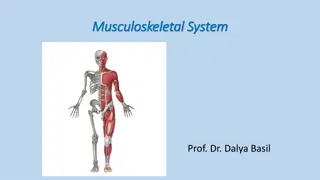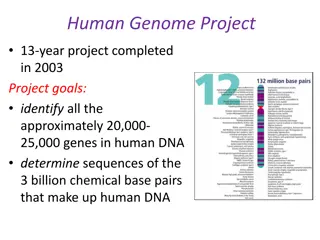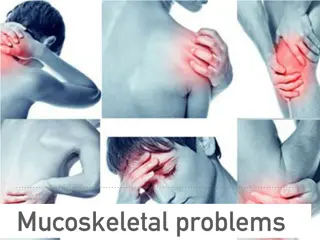Functions and Disorders of the Human Musculoskeletal System
The human musculoskeletal system is vital for mobility and protection. Understand the functions of the skeleton, such as bone elongation, blood cell formation, and muscle attachment. Learn about disorders like arthritis and osteoporosis that affect this system's health and function. Explore how ligaments, tendons, and muscles play crucial roles in the movement and support of the body. Discover more about the spine, limbs, and other skeletal components in detail.
Download Presentation

Please find below an Image/Link to download the presentation.
The content on the website is provided AS IS for your information and personal use only. It may not be sold, licensed, or shared on other websites without obtaining consent from the author.If you encounter any issues during the download, it is possible that the publisher has removed the file from their server.
You are allowed to download the files provided on this website for personal or commercial use, subject to the condition that they are used lawfully. All files are the property of their respective owners.
The content on the website is provided AS IS for your information and personal use only. It may not be sold, licensed, or shared on other websites without obtaining consent from the author.
E N D
Presentation Transcript
3.5.3 Responses in the Human Musculoskeletal System Follow-Me iQuiz
Q. Give two functions of the human skeleton. Antagonistic muscle pair Formation of blood cells Protection; Reduces friction; Allows bone elongation Protection; Reduces friction; Allows bone elongation Antagonistic muscle pair Formation of blood cells Shock absorption; Friction-free movement; Prevent wear and tear Arthritis; Osteoporosis Hinge; Synovial Shock absorption; Friction- free movement; Prevent wear and tear Arthritis; Osteoporosis Hinge; Synovial Back of chest Ligaments Spinal cord Back of chest Ligaments Spinal cord Between vertebrae Lightweight; Allow flight Strength; Muscle attachment; Blood cell production Strength; Muscle attachment; Blood cell production Between vertebrae Lightweight; Allow flight Lubrication; Shock absorption; Protection Strength; Rigidity; Makes marrow Biceps Lubrication; Shock absorption; Protection Strength; Rigidity; Makes marrow Biceps Cervical Lumbar Tail end of spinal column Cervical Lumbar Tail end of spinal column Fat storage; Can convert to red marrow Tendons Makes yellow marrow; Stores fat; Makes blood cells Fat storage; Can convert to red marrow Makes yellow marrow; Stores fat; Makes blood cells Tendons Femur; Tibia; Fibula; Humerus; Radius; Ulna Vertebral column, skull and rib cage Muscle Femur; Tibia; Fibula; Humerus; Radius; Ulna Vertebral column, skull and rib cage Muscle
CONGRATULATIONS Please CLICK on THIS BOX for the Next Question Please CLICK on THIS BOX for the Next Question
Q. Name one disorder of the musculoskeletal system. Antagonistic muscle pair Formation of blood cells Protection; Reduces friction; Allows bone elongation Protection; Reduces friction; Allows bone elongation Antagonistic muscle pair Formation of blood cells Shock absorption; Friction-free movement; Prevent wear and tear Arthritis; Osteoporosis Hinge; Synovial Shock absorption; Friction- free movement; Prevent wear and tear Arthritis; Osteoporosis Hinge; Synovial Back of chest Ligaments Spinal cord Back of chest Ligaments Spinal cord Between vertebrae Lightweight; Allow flight Strength; Muscle attachment; Blood cell production Strength; Muscle attachment; Blood cell production Between vertebrae Lightweight; Allow flight Lubrication; Shock absorption; Protection Strength; Rigidity; Makes marrow Biceps Lubrication; Shock absorption; Protection Strength; Rigidity; Makes marrow Biceps Cervical Lumbar Tail end of spinal column Cervical Lumbar Tail end of spinal column Fat storage; Can convert to red marrow Tendons Makes yellow marrow; Stores fat; Makes blood cells Fat storage; Can convert to red marrow Makes yellow marrow; Stores fat; Makes blood cells Tendons Femur; Tibia; Fibula; Humerus; Radius; Ulna Vertebral column, skull and rib cage Muscle Femur; Tibia; Fibula; Humerus; Radius; Ulna Vertebral column, skull and rib cage Muscle
CONGRATULATIONS Please CLICK on THIS BOX for the Next Question Please CLICK on THIS BOX for the Next Question
Q. Explain what is meant by the axial skeleton? Antagonistic muscle pair Formation of blood cells Protection; Reduces friction; Allows bone elongation Protection; Reduces friction; Allows bone elongation Antagonistic muscle pair Formation of blood cells Shock absorption; Friction-free movement; Prevent wear and tear Arthritis; Osteoporosis Hinge; Synovial Shock absorption; Friction- free movement; Prevent wear and tear Arthritis; Osteoporosis Hinge; Synovial Back of chest Ligaments Spinal cord Back of chest Ligaments Spinal cord Between vertebrae Lightweight; Allow flight Strength; Muscle attachment; Blood cell production Strength; Muscle attachment; Blood cell production Between vertebrae Lightweight; Allow flight Lubrication; Shock absorption; Protection Strength; Rigidity; Makes marrow Biceps Lubrication; Shock absorption; Protection Strength; Rigidity; Makes marrow Biceps Cervical Lumbar Tail end of spinal column Cervical Lumbar Tail end of spinal column Fat storage; Can convert to red marrow Tendons Makes yellow marrow; Stores fat; Makes blood cells Fat storage; Can convert to red marrow Makes yellow marrow; Stores fat; Makes blood cells Tendons Femur; Tibia; Fibula; Humerus; Radius; Ulna Vertebral column, skull and rib cage Muscle Femur; Tibia; Fibula; Humerus; Radius; Ulna Vertebral column, skull and rib cage Muscle
CONGRATULATIONS Please CLICK on THIS BOX for the Next Question Please CLICK on THIS BOX for the Next Question
Q. Give a function of Red marrow. Antagonistic muscle pair Formation of blood cells Protection; Reduces friction; Allows bone elongation Protection; Reduces friction; Allows bone elongation Antagonistic muscle pair Formation of blood cells Shock absorption; Friction-free movement; Prevent wear and tear Arthritis; Osteoporosis Hinge; Synovial Shock absorption; Friction- free movement; Prevent wear and tear Arthritis; Osteoporosis Hinge; Synovial Back of chest Ligaments Spinal cord Back of chest Ligaments Spinal cord Between vertebrae Lightweight; Allow flight Strength; Muscle attachment; Blood cell production Strength; Muscle attachment; Blood cell production Between vertebrae Lightweight; Allow flight Lubrication; Shock absorption; Protection Strength; Rigidity; Makes marrow Biceps Lubrication; Shock absorption; Protection Strength; Rigidity; Makes marrow Biceps Cervical Lumbar Tail end of spinal column Cervical Lumbar Tail end of spinal column Fat storage; Can convert to red marrow Tendons Makes yellow marrow; Stores fat; Makes blood cells Fat storage; Can convert to red marrow Makes yellow marrow; Stores fat; Makes blood cells Tendons Femur; Tibia; Fibula; Humerus; Radius; Ulna Vertebral column, skull and rib cage Muscle Femur; Tibia; Fibula; Humerus; Radius; Ulna Vertebral column, skull and rib cage Muscle
CONGRATULATIONS Please CLICK on THIS BOX for the Next Question Please CLICK on THIS BOX for the Next Question
Q. A pair of muscles that have opposite effects are called Antagonistic muscle pair Formation of blood cells Protection; Reduces friction; Allows bone elongation Protection; Reduces friction; Allows bone elongation Antagonistic muscle pair Formation of blood cells Shock absorption; Friction-free movement; Prevent wear and tear Arthritis; Osteoporosis Hinge; Synovial Shock absorption; Friction- free movement; Prevent wear and tear Arthritis; Osteoporosis Hinge; Synovial Back of chest Ligaments Spinal cord Back of chest Ligaments Spinal cord Between vertebrae Lightweight; Allow flight Strength; Muscle attachment; Blood cell production Strength; Muscle attachment; Blood cell production Between vertebrae Lightweight; Allow flight Lubrication; Shock absorption; Protection Strength; Rigidity; Makes marrow Biceps Lubrication; Shock absorption; Protection Strength; Rigidity; Makes marrow Biceps Cervical Lumbar Tail end of spinal column Cervical Lumbar Tail end of spinal column Fat storage; Can convert to red marrow Tendons Makes yellow marrow; Stores fat; Makes blood cells Fat storage; Can convert to red marrow Makes yellow marrow; Stores fat; Makes blood cells Tendons Femur; Tibia; Fibula; Humerus; Radius; Ulna Vertebral column, skull and rib cage Muscle Femur; Tibia; Fibula; Humerus; Radius; Ulna Vertebral column, skull and rib cage Muscle
CONGRATULATIONS Please CLICK on THIS BOX for the Next Question Please CLICK on THIS BOX for the Next Question
Q. Give a function of Cartilage. Antagonistic muscle pair Formation of blood cells Protection; Reduces friction; Allows bone elongation Protection; Reduces friction; Allows bone elongation Antagonistic muscle pair Formation of blood cells Shock absorption; Friction-free movement; Prevent wear and tear Arthritis; Osteoporosis Hinge; Synovial Shock absorption; Friction- free movement; Prevent wear and tear Arthritis; Osteoporosis Hinge; Synovial Back of chest Ligaments Spinal cord Back of chest Ligaments Spinal cord Between vertebrae Lightweight; Allow flight Strength; Muscle attachment; Blood cell production Strength; Muscle attachment; Blood cell production Between vertebrae Lightweight; Allow flight Lubrication; Shock absorption; Protection Strength; Rigidity; Makes marrow Biceps Lubrication; Shock absorption; Protection Strength; Rigidity; Makes marrow Biceps Cervical Lumbar Tail end of spinal column Cervical Lumbar Tail end of spinal column Fat storage; Can convert to red marrow Tendons Makes yellow marrow; Stores fat; Makes blood cells Fat storage; Can convert to red marrow Makes yellow marrow; Stores fat; Makes blood cells Tendons Femur; Tibia; Fibula; Humerus; Radius; Ulna Vertebral column, skull and rib cage Muscle Femur; Tibia; Fibula; Humerus; Radius; Ulna Vertebral column, skull and rib cage Muscle
CONGRATULATIONS Please CLICK on THIS BOX for the Next Question Please CLICK on THIS BOX for the Next Question
Q. Where are the discs in the human backbone? Antagonistic muscle pair Formation of blood cells Protection; Reduces friction; Allows bone elongation Protection; Reduces friction; Allows bone elongation Antagonistic muscle pair Formation of blood cells Shock absorption; Friction-free movement; Prevent wear and tear Arthritis; Osteoporosis Hinge; Synovial Shock absorption; Friction- free movement; Prevent wear and tear Arthritis; Osteoporosis Hinge; Synovial Back of chest Ligaments Spinal cord Back of chest Ligaments Spinal cord Between vertebrae Lightweight; Allow flight Strength; Muscle attachment; Blood cell production Strength; Muscle attachment; Blood cell production Between vertebrae Lightweight; Allow flight Lubrication; Shock absorption; Protection Strength; Rigidity; Makes marrow Biceps Lubrication; Shock absorption; Protection Strength; Rigidity; Makes marrow Biceps Cervical Lumbar Tail end of spinal column Cervical Lumbar Tail end of spinal column Fat storage; Can convert to red marrow Tendons Makes yellow marrow; Stores fat; Makes blood cells Fat storage; Can convert to red marrow Makes yellow marrow; Stores fat; Makes blood cells Tendons Femur; Tibia; Fibula; Humerus; Radius; Ulna Vertebral column, skull and rib cage Muscle Femur; Tibia; Fibula; Humerus; Radius; Ulna Vertebral column, skull and rib cage Muscle
CONGRATULATIONS Please CLICK on THIS BOX for the Next Question Please CLICK on THIS BOX for the Next Question
Q. Where are thoracic vertebrae found? Antagonistic muscle pair Formation of blood cells Protection; Reduces friction; Allows bone elongation Protection; Reduces friction; Allows bone elongation Antagonistic muscle pair Formation of blood cells Shock absorption; Friction-free movement; Prevent wear and tear Arthritis; Osteoporosis Hinge; Synovial Shock absorption; Friction- free movement; Prevent wear and tear Arthritis; Osteoporosis Hinge; Synovial Back of chest Ligaments Spinal cord Back of chest Ligaments Spinal cord Between vertebrae Lightweight; Allow flight Strength; Muscle attachment; Blood cell production Strength; Muscle attachment; Blood cell production Between vertebrae Lightweight; Allow flight Lubrication; Shock absorption; Protection Strength; Rigidity; Makes marrow Biceps Lubrication; Shock absorption; Protection Strength; Rigidity; Makes marrow Biceps Cervical Lumbar Tail end of spinal column Cervical Lumbar Tail end of spinal column Fat storage; Can convert to red marrow Tendons Makes yellow marrow; Stores fat; Makes blood cells Fat storage; Can convert to red marrow Makes yellow marrow; Stores fat; Makes blood cells Tendons Femur; Tibia; Fibula; Humerus; Radius; Ulna Vertebral column, skull and rib cage Muscle Femur; Tibia; Fibula; Humerus; Radius; Ulna Vertebral column, skull and rib cage Muscle
CONGRATULATIONS Please CLICK on THIS BOX for the Next Question Please CLICK on THIS BOX for the Next Question
Q. Muscles are joined to bones by ... Antagonistic muscle pair Formation of blood cells Protection; Reduces friction; Allows bone elongation Protection; Reduces friction; Allows bone elongation Antagonistic muscle pair Formation of blood cells Shock absorption; Friction-free movement; Prevent wear and tear Arthritis; Osteoporosis Hinge; Synovial Shock absorption; Friction- free movement; Prevent wear and tear Arthritis; Osteoporosis Hinge; Synovial Back of chest Ligaments Spinal cord Back of chest Ligaments Spinal cord Between vertebrae Lightweight; Allow flight Strength; Muscle attachment; Blood cell production Strength; Muscle attachment; Blood cell production Between vertebrae Lightweight; Allow flight Lubrication; Shock absorption; Protection Strength; Rigidity; Makes marrow Biceps Lubrication; Shock absorption; Protection Strength; Rigidity; Makes marrow Biceps Cervical Lumbar Tail end of spinal column Cervical Lumbar Tail end of spinal column Fat storage; Can convert to red marrow Tendons Makes yellow marrow; Stores fat; Makes blood cells Fat storage; Can convert to red marrow Makes yellow marrow; Stores fat; Makes blood cells Tendons Femur; Tibia; Fibula; Humerus; Radius; Ulna Vertebral column, skull and rib cage Muscle Femur; Tibia; Fibula; Humerus; Radius; Ulna Vertebral column, skull and rib cage Muscle
CONGRATULATIONS Please CLICK on THIS BOX for the Next Question Please CLICK on THIS BOX for the Next Question
Q. Where are caudal vertebrae found? Antagonistic muscle pair Formation of blood cells Protection; Reduces friction; Allows bone elongation Protection; Reduces friction; Allows bone elongation Antagonistic muscle pair Formation of blood cells Shock absorption; Friction-free movement; Prevent wear and tear Arthritis; Osteoporosis Hinge; Synovial Shock absorption; Friction- free movement; Prevent wear and tear Arthritis; Osteoporosis Hinge; Synovial Back of chest Ligaments Spinal cord Back of chest Ligaments Spinal cord Between vertebrae Lightweight; Allow flight Strength; Muscle attachment; Blood cell production Strength; Muscle attachment; Blood cell production Between vertebrae Lightweight; Allow flight Lubrication; Shock absorption; Protection Strength; Rigidity; Makes marrow Biceps Lubrication; Shock absorption; Protection Strength; Rigidity; Makes marrow Biceps Cervical Lumbar Tail end of spinal column Cervical Lumbar Tail end of spinal column Fat storage; Can convert to red marrow Tendons Makes yellow marrow; Stores fat; Makes blood cells Fat storage; Can convert to red marrow Makes yellow marrow; Stores fat; Makes blood cells Tendons Femur; Tibia; Fibula; Humerus; Radius; Ulna Vertebral column, skull and rib cage Muscle Femur; Tibia; Fibula; Humerus; Radius; Ulna Vertebral column, skull and rib cage Muscle
CONGRATULATIONS Please CLICK on THIS BOX for the Next Question Please CLICK on THIS BOX for the Next Question
Q. What is the function of the discs in the human backbone? Antagonistic muscle pair Formation of blood cells Protection; Reduces friction; Allows bone elongation Protection; Reduces friction; Allows bone elongation Antagonistic muscle pair Formation of blood cells Shock absorption; Friction-free movement; Prevent wear and tear Arthritis; Osteoporosis Hinge; Synovial Shock absorption; Friction- free movement; Prevent wear and tear Arthritis; Osteoporosis Hinge; Synovial Back of chest Ligaments Spinal cord Back of chest Ligaments Spinal cord Between vertebrae Lightweight; Allow flight Strength; Muscle attachment; Blood cell production Strength; Muscle attachment; Blood cell production Between vertebrae Lightweight; Allow flight Lubrication; Shock absorption; Protection Strength; Rigidity; Makes marrow Biceps Lubrication; Shock absorption; Protection Strength; Rigidity; Makes marrow Biceps Cervical Lumbar Tail end of spinal column Cervical Lumbar Tail end of spinal column Fat storage; Can convert to red marrow Tendons Makes yellow marrow; Stores fat; Makes blood cells Fat storage; Can convert to red marrow Makes yellow marrow; Stores fat; Makes blood cells Tendons Femur; Tibia; Fibula; Humerus; Radius; Ulna Vertebral column, skull and rib cage Muscle Femur; Tibia; Fibula; Humerus; Radius; Ulna Vertebral column, skull and rib cage Muscle
CONGRATULATIONS Please CLICK on THIS BOX for the Next Question Please CLICK on THIS BOX for the Next Question
Q. Give a role of Yellow bone marrow. Antagonistic muscle pair Formation of blood cells Protection; Reduces friction; Allows bone elongation Protection; Reduces friction; Allows bone elongation Antagonistic muscle pair Formation of blood cells Shock absorption; Friction-free movement; Prevent wear and tear Arthritis; Osteoporosis Hinge; Synovial Shock absorption; Friction- free movement; Prevent wear and tear Arthritis; Osteoporosis Hinge; Synovial Back of chest Ligaments Spinal cord Back of chest Ligaments Spinal cord Between vertebrae Lightweight; Allow flight Strength; Muscle attachment; Blood cell production Strength; Muscle attachment; Blood cell production Between vertebrae Lightweight; Allow flight Lubrication; Shock absorption; Protection Strength; Rigidity; Makes marrow Biceps Lubrication; Shock absorption; Protection Strength; Rigidity; Makes marrow Biceps Cervical Lumbar Tail end of spinal column Cervical Lumbar Tail end of spinal column Fat storage; Can convert to red marrow Tendons Makes yellow marrow; Stores fat; Makes blood cells Fat storage; Can convert to red marrow Makes yellow marrow; Stores fat; Makes blood cells Tendons Femur; Tibia; Fibula; Humerus; Radius; Ulna Vertebral column, skull and rib cage Muscle Femur; Tibia; Fibula; Humerus; Radius; Ulna Vertebral column, skull and rib cage Muscle
CONGRATULATIONS Please CLICK on THIS BOX for the Next Question Please CLICK on THIS BOX for the Next Question
Q. Name a long bone in the human body. Antagonistic muscle pair Formation of blood cells Protection; Reduces friction; Allows bone elongation Protection; Reduces friction; Allows bone elongation Antagonistic muscle pair Formation of blood cells Shock absorption; Friction-free movement; Prevent wear and tear Arthritis; Osteoporosis Hinge; Synovial Shock absorption; Friction- free movement; Prevent wear and tear Arthritis; Osteoporosis Hinge; Synovial Back of chest Ligaments Spinal cord Back of chest Ligaments Spinal cord Between vertebrae Lightweight; Allow flight Strength; Muscle attachment; Blood cell production Strength; Muscle attachment; Blood cell production Between vertebrae Lightweight; Allow flight Lubrication; Shock absorption; Protection Strength; Rigidity; Makes marrow Biceps Lubrication; Shock absorption; Protection Strength; Rigidity; Makes marrow Biceps Cervical Lumbar Tail end of spinal column Cervical Lumbar Tail end of spinal column Fat storage; Can convert to red marrow Tendons Makes yellow marrow; Stores fat; Makes blood cells Fat storage; Can convert to red marrow Makes yellow marrow; Stores fat; Makes blood cells Tendons Femur; Tibia; Fibula; Humerus; Radius; Ulna Vertebral column, skull and rib cage Muscle Femur; Tibia; Fibula; Humerus; Radius; Ulna Vertebral column, skull and rib cage Muscle
CONGRATULATIONS Please CLICK on THIS BOX for the Next Question Please CLICK on THIS BOX for the Next Question
Q. State a function of spongy bone. Antagonistic muscle pair Formation of blood cells Protection; Reduces friction; Allows bone elongation Protection; Reduces friction; Allows bone elongation Antagonistic muscle pair Formation of blood cells Shock absorption; Friction-free movement; Prevent wear and tear Arthritis; Osteoporosis Hinge; Synovial Shock absorption; Friction- free movement; Prevent wear and tear Arthritis; Osteoporosis Hinge; Synovial Back of chest Ligaments Spinal cord Back of chest Ligaments Spinal cord Between vertebrae Lightweight; Allow flight Strength; Muscle attachment; Blood cell production Strength; Muscle attachment; Blood cell production Between vertebrae Lightweight; Allow flight Lubrication; Shock absorption; Protection Strength; Rigidity; Makes marrow Biceps Lubrication; Shock absorption; Protection Strength; Rigidity; Makes marrow Biceps Cervical Lumbar Tail end of spinal column Cervical Lumbar Tail end of spinal column Fat storage; Can convert to red marrow Tendons Makes yellow marrow; Stores fat; Makes blood cells Fat storage; Can convert to red marrow Makes yellow marrow; Stores fat; Makes blood cells Tendons Femur; Tibia; Fibula; Humerus; Radius; Ulna Vertebral column, skull and rib cage Muscle Femur; Tibia; Fibula; Humerus; Radius; Ulna Vertebral column, skull and rib cage Muscle
CONGRATULATIONS Please CLICK on THIS BOX for the Next Question Please CLICK on THIS BOX for the Next Question
Q. State a function of medullary cavity. Antagonistic muscle pair Formation of blood cells Protection; Reduces friction; Allows bone elongation Protection; Reduces friction; Allows bone elongation Antagonistic muscle pair Formation of blood cells Shock absorption; Friction-free movement; Prevent wear and tear Arthritis; Osteoporosis Hinge; Synovial Shock absorption; Friction- free movement; Prevent wear and tear Arthritis; Osteoporosis Hinge; Synovial Back of chest Ligaments Spinal cord Back of chest Ligaments Spinal cord Between vertebrae Lightweight; Allow flight Strength; Muscle attachment; Blood cell production Strength; Muscle attachment; Blood cell production Between vertebrae Lightweight; Allow flight Lubrication; Shock absorption; Protection Strength; Rigidity; Makes marrow Biceps Lubrication; Shock absorption; Protection Strength; Rigidity; Makes marrow Biceps Cervical Lumbar Tail end of spinal column Cervical Lumbar Tail end of spinal column Fat storage; Can convert to red marrow Tendons Makes yellow marrow; Stores fat; Makes blood cells Fat storage; Can convert to red marrow Makes yellow marrow; Stores fat; Makes blood cells Tendons Femur; Tibia; Fibula; Humerus; Radius; Ulna Vertebral column, skull and rib cage Muscle Femur; Tibia; Fibula; Humerus; Radius; Ulna Vertebral column, skull and rib cage Muscle
CONGRATULATIONS Please CLICK on THIS BOX for the Next Question Please CLICK on THIS BOX for the Next Question
Q. Bones are joined to other bones by ... Antagonistic muscle pair Formation of blood cells Protection; Reduces friction; Allows bone elongation Protection; Reduces friction; Allows bone elongation Antagonistic muscle pair Formation of blood cells Shock absorption; Friction-free movement; Prevent wear and tear Arthritis; Osteoporosis Hinge; Synovial Shock absorption; Friction- free movement; Prevent wear and tear Arthritis; Osteoporosis Hinge; Synovial Back of chest Ligaments Spinal cord Back of chest Ligaments Spinal cord Between vertebrae Lightweight; Allow flight Strength; Muscle attachment; Blood cell production Strength; Muscle attachment; Blood cell production Between vertebrae Lightweight; Allow flight Lubrication; Shock absorption; Protection Strength; Rigidity; Makes marrow Biceps Lubrication; Shock absorption; Protection Strength; Rigidity; Makes marrow Biceps Cervical Lumbar Tail end of spinal column Cervical Lumbar Tail end of spinal column Fat storage; Can convert to red marrow Tendons Makes yellow marrow; Stores fat; Makes blood cells Fat storage; Can convert to red marrow Makes yellow marrow; Stores fat; Makes blood cells Tendons Femur; Tibia; Fibula; Humerus; Radius; Ulna Vertebral column, skull and rib cage Muscle Femur; Tibia; Fibula; Humerus; Radius; Ulna Vertebral column, skull and rib cage Muscle
CONGRATULATIONS Please CLICK on THIS BOX for the Next Question Please CLICK on THIS BOX for the Next Question
Q. Name the vertebrae found in the neck. Antagonistic muscle pair Formation of blood cells Protection; Reduces friction; Allows bone elongation Protection; Reduces friction; Allows bone elongation Antagonistic muscle pair Formation of blood cells Shock absorption; Friction-free movement; Prevent wear and tear Arthritis; Osteoporosis Hinge; Synovial Shock absorption; Friction- free movement; Prevent wear and tear Arthritis; Osteoporosis Hinge; Synovial Back of chest Ligaments Spinal cord Back of chest Ligaments Spinal cord Between vertebrae Lightweight; Allow flight Strength; Muscle attachment; Blood cell production Strength; Muscle attachment; Blood cell production Between vertebrae Lightweight; Allow flight Lubrication; Shock absorption; Protection Strength; Rigidity; Makes marrow Biceps Lubrication; Shock absorption; Protection Strength; Rigidity; Makes marrow Biceps Cervical Lumbar Tail end of spinal column Cervical Lumbar Tail end of spinal column Fat storage; Can convert to red marrow Tendons Makes yellow marrow; Stores fat; Makes blood cells Fat storage; Can convert to red marrow Makes yellow marrow; Stores fat; Makes blood cells Tendons Femur; Tibia; Fibula; Humerus; Radius; Ulna Vertebral column, skull and rib cage Muscle Femur; Tibia; Fibula; Humerus; Radius; Ulna Vertebral column, skull and rib cage Muscle
CONGRATULATIONS Please CLICK on THIS BOX for the Next Question Please CLICK on THIS BOX for the Next Question
Q. Name the part of the central nervous system that runs through the vertebrae. Antagonistic muscle pair Formation of blood cells Protection; Reduces friction; Allows bone elongation Protection; Reduces friction; Allows bone elongation Antagonistic muscle pair Formation of blood cells Shock absorption; Friction-free movement; Prevent wear and tear Arthritis; Osteoporosis Hinge; Synovial Shock absorption; Friction- free movement; Prevent wear and tear Arthritis; Osteoporosis Hinge; Synovial Back of chest Ligaments Spinal cord Back of chest Ligaments Spinal cord Between vertebrae Lightweight; Allow flight Strength; Muscle attachment; Blood cell production Strength; Muscle attachment; Blood cell production Between vertebrae Lightweight; Allow flight Lubrication; Shock absorption; Protection Strength; Rigidity; Makes marrow Biceps Lubrication; Shock absorption; Protection Strength; Rigidity; Makes marrow Biceps Cervical Lumbar Tail end of spinal column Cervical Lumbar Tail end of spinal column Fat storage; Can convert to red marrow Tendons Makes yellow marrow; Stores fat; Makes blood cells Fat storage; Can convert to red marrow Makes yellow marrow; Stores fat; Makes blood cells Tendons Femur; Tibia; Fibula; Humerus; Radius; Ulna Vertebral column, skull and rib cage Muscle Femur; Tibia; Fibula; Humerus; Radius; Ulna Vertebral column, skull and rib cage Muscle
CONGRATULATIONS Please CLICK on THIS BOX for the Next Question Please CLICK on THIS BOX for the Next Question
Q. A tendon joins ... to bone. Antagonistic muscle pair Formation of blood cells Protection; Reduces friction; Allows bone elongation Protection; Reduces friction; Allows bone elongation Antagonistic muscle pair Formation of blood cells Shock absorption; Friction-free movement; Prevent wear and tear Arthritis; Osteoporosis Hinge; Synovial Shock absorption; Friction- free movement; Prevent wear and tear Arthritis; Osteoporosis Hinge; Synovial Back of chest Ligaments Spinal cord Back of chest Ligaments Spinal cord Between vertebrae Lightweight; Allow flight Strength; Muscle attachment; Blood cell production Strength; Muscle attachment; Blood cell production Between vertebrae Lightweight; Allow flight Lubrication; Shock absorption; Protection Strength; Rigidity; Makes marrow Biceps Lubrication; Shock absorption; Protection Strength; Rigidity; Makes marrow Biceps Cervical Lumbar Tail end of spinal column Cervical Lumbar Tail end of spinal column Fat storage; Can convert to red marrow Tendons Makes yellow marrow; Stores fat; Makes blood cells Fat storage; Can convert to red marrow Makes yellow marrow; Stores fat; Makes blood cells Tendons Femur; Tibia; Fibula; Humerus; Radius; Ulna Vertebral column, skull and rib cage Muscle Femur; Tibia; Fibula; Humerus; Radius; Ulna Vertebral column, skull and rib cage Muscle
CONGRATULATIONS Please CLICK on THIS BOX for the Next Question Please CLICK on THIS BOX for the Next Question
Q. Give a function of synovial fluid. Antagonistic muscle pair Formation of blood cells Protection; Reduces friction; Allows bone elongation Protection; Reduces friction; Allows bone elongation Antagonistic muscle pair Formation of blood cells Shock absorption; Friction-free movement; Prevent wear and tear Arthritis; Osteoporosis Hinge; Synovial Shock absorption; Friction- free movement; Prevent wear and tear Arthritis; Osteoporosis Hinge; Synovial Back of chest Ligaments Spinal cord Back of chest Ligaments Spinal cord Between vertebrae Lightweight; Allow flight Strength; Muscle attachment; Blood cell production Strength; Muscle attachment; Blood cell production Between vertebrae Lightweight; Allow flight Lubrication; Shock absorption; Protection Strength; Rigidity; Makes marrow Biceps Lubrication; Shock absorption; Protection Strength; Rigidity; Makes marrow Biceps Cervical Lumbar Tail end of spinal column Cervical Lumbar Tail end of spinal column Fat storage; Can convert to red marrow Tendons Makes yellow marrow; Stores fat; Makes blood cells Fat storage; Can convert to red marrow Makes yellow marrow; Stores fat; Makes blood cells Tendons Femur; Tibia; Fibula; Humerus; Radius; Ulna Vertebral column, skull and rib cage Muscle Femur; Tibia; Fibula; Humerus; Radius; Ulna Vertebral column, skull and rib cage Muscle
CONGRATULATIONS Please CLICK on THIS BOX for the Next Question Please CLICK on THIS BOX for the Next Question
Q. Name the vertebrae found in the small of the back. Antagonistic muscle pair Formation of blood cells Protection; Reduces friction; Allows bone elongation Protection; Reduces friction; Allows bone elongation Antagonistic muscle pair Formation of blood cells Shock absorption; Friction-free movement; Prevent wear and tear Arthritis; Osteoporosis Hinge; Synovial Shock absorption; Friction- free movement; Prevent wear and tear Arthritis; Osteoporosis Hinge; Synovial Back of chest Ligaments Spinal cord Back of chest Ligaments Spinal cord Between vertebrae Lightweight; Allow flight Strength; Muscle attachment; Blood cell production Strength; Muscle attachment; Blood cell production Between vertebrae Lightweight; Allow flight Lubrication; Shock absorption; Protection Strength; Rigidity; Makes marrow Biceps Lubrication; Shock absorption; Protection Strength; Rigidity; Makes marrow Biceps Cervical Lumbar Tail end of spinal column Cervical Lumbar Tail end of spinal column Fat storage; Can convert to red marrow Tendons Makes yellow marrow; Stores fat; Makes blood cells Fat storage; Can convert to red marrow Makes yellow marrow; Stores fat; Makes blood cells Tendons Femur; Tibia; Fibula; Humerus; Radius; Ulna Vertebral column, skull and rib cage Muscle Femur; Tibia; Fibula; Humerus; Radius; Ulna Vertebral column, skull and rib cage Muscle
CONGRATULATIONS Please CLICK on THIS BOX for the Next Question Please CLICK on THIS BOX for the Next Question
Q. Which upper arm muscle contracts to raise the lower arm? Antagonistic muscle pair Formation of blood cells Protection; Reduces friction; Allows bone elongation Protection; Reduces friction; Allows bone elongation Antagonistic muscle pair Formation of blood cells Shock absorption; Friction-free movement; Prevent wear and tear Arthritis; Osteoporosis Hinge; Synovial Shock absorption; Friction- free movement; Prevent wear and tear Arthritis; Osteoporosis Hinge; Synovial Back of chest Ligaments Spinal cord Back of chest Ligaments Spinal cord Between vertebrae Lightweight; Allow flight Strength; Muscle attachment; Blood cell production Strength; Muscle attachment; Blood cell production Between vertebrae Lightweight; Allow flight Lubrication; Shock absorption; Protection Strength; Rigidity; Makes marrow Biceps Lubrication; Shock absorption; Protection Strength; Rigidity; Makes marrow Biceps Cervical Lumbar Tail end of spinal column Cervical Lumbar Tail end of spinal column Fat storage; Can convert to red marrow Tendons Makes yellow marrow; Stores fat; Makes blood cells Fat storage; Can convert to red marrow Makes yellow marrow; Stores fat; Makes blood cells Tendons Femur; Tibia; Fibula; Humerus; Radius; Ulna Vertebral column, skull and rib cage Muscle Femur; Tibia; Fibula; Humerus; Radius; Ulna Vertebral column, skull and rib cage Muscle
CONGRATULATIONS Please CLICK on THIS BOX for the Next Question Please CLICK on THIS BOX for the Next Question
Q. Name the type of joint at the elbow. Antagonistic muscle pair Formation of blood cells Protection; Reduces friction; Allows bone elongation Protection; Reduces friction; Allows bone elongation Antagonistic muscle pair Formation of blood cells Shock absorption; Friction-free movement; Prevent wear and tear Arthritis; Osteoporosis Hinge; Synovial Shock absorption; Friction- free movement; Prevent wear and tear Arthritis; Osteoporosis Hinge; Synovial Back of chest Ligaments Spinal cord Back of chest Ligaments Spinal cord Between vertebrae Lightweight; Allow flight Strength; Muscle attachment; Blood cell production Strength; Muscle attachment; Blood cell production Between vertebrae Lightweight; Allow flight Lubrication; Shock absorption; Protection Strength; Rigidity; Makes marrow Biceps Lubrication; Shock absorption; Protection Strength; Rigidity; Makes marrow Biceps Cervical Lumbar Tail end of spinal column Cervical Lumbar Tail end of spinal column Fat storage; Can convert to red marrow Tendons Makes yellow marrow; Stores fat; Makes blood cells Fat storage; Can convert to red marrow Makes yellow marrow; Stores fat; Makes blood cells Tendons Femur; Tibia; Fibula; Humerus; Radius; Ulna Vertebral column, skull and rib cage Muscle Femur; Tibia; Fibula; Humerus; Radius; Ulna Vertebral column, skull and rib cage Muscle
CONGRATULATIONS Please CLICK on THIS BOX for the Next Question Please CLICK on THIS BOX for the Next Question
Q. Suggest one reason why the bones of birds are almost hollow. Antagonistic muscle pair Formation of blood cells Protection; Reduces friction; Allows bone elongation Protection; Reduces friction; Allows bone elongation Antagonistic muscle pair Formation of blood cells Shock absorption; Friction-free movement; Prevent wear and tear Arthritis; Osteoporosis Hinge; Synovial Shock absorption; Friction- free movement; Prevent wear and tear Arthritis; Osteoporosis Hinge; Synovial Back of chest Ligaments Spinal cord Back of chest Ligaments Spinal cord Between vertebrae Lightweight; Allow flight Strength; Muscle attachment; Blood cell production Strength; Muscle attachment; Blood cell production Between vertebrae Lightweight; Allow flight Lubrication; Shock absorption; Protection Strength; Rigidity; Makes marrow Biceps Lubrication; Shock absorption; Protection Strength; Rigidity; Makes marrow Biceps Cervical Lumbar Tail end of spinal column Cervical Lumbar Tail end of spinal column Fat storage; Can convert to red marrow Tendons Makes yellow marrow; Stores fat; Makes blood cells Fat storage; Can convert to red marrow Makes yellow marrow; Stores fat; Makes blood cells Tendons Femur; Tibia; Fibula; Humerus; Radius; Ulna Vertebral column, skull and rib cage Muscle Femur; Tibia; Fibula; Humerus; Radius; Ulna Vertebral column, skull and rib cage Muscle
CONGRATULATIONS You re Brilliant
Incorrect Please CLICK on THIS BOX to Try Again Please CLICK on THIS BOX to Try Again
